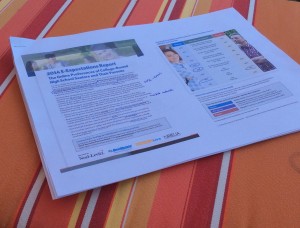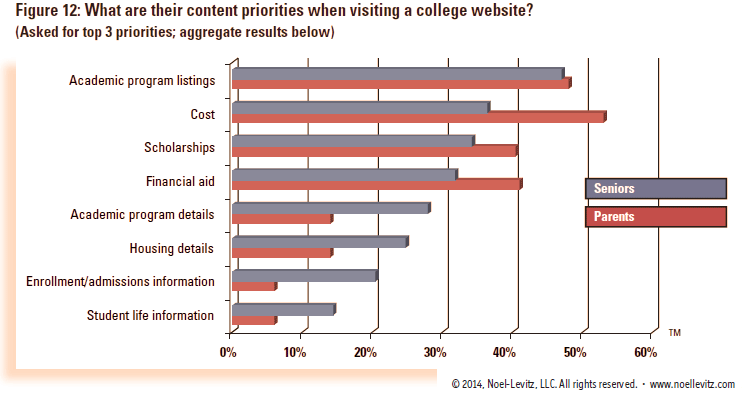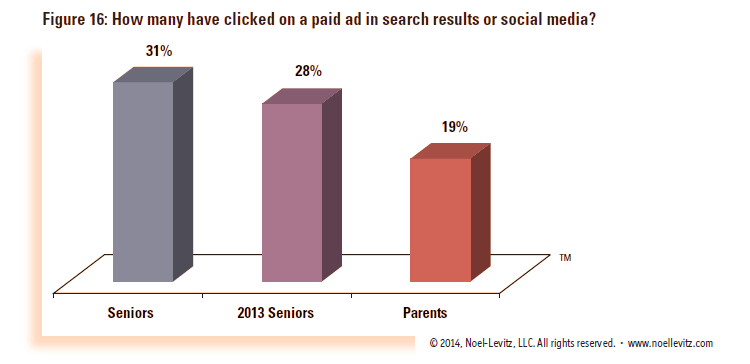 The brand new Noel-Levitz report on the E-expectations of college bound seniors and their parents has been released this morning.
The brand new Noel-Levitz report on the E-expectations of college bound seniors and their parents has been released this morning.
I had the opportunity to spend time reviewing it before its official release as Stephanie Geyer from Noel-Levitz emailed me a copy of the final report last week, so YOU get a chance to know what’s in it before everybody else :-)
With the extra time, I was able to identify the most interesting points in this 20-page report (PDF).
As you know, this yearly E-Expectations research always provides very interesting insights on the preferences of college-bound high school students when it comes to the college admission process.
This year, the results are based on a phone survey conducted in March 2014 with a sample of a 1,000 college-bound seniors and 533 parents, so the data is fresh and relevant to any institution recruiting prospective college-aged students in the US.
I’ve identified 5 interesting insights from the full 20-page report.
1) Your school website is still the ONE for prospective students… and their top influencers: their parents
When it’s time to make a decision for students and parents, the college website is always the most popular influential college search resource – before college emails, college planning sites, college rating sites, college ranking magazines, Facebook & Twitter posts from colleges.
For 77% of seniors (75% in 2013) and 69% of parents, your school website is an influential source of information.

And, the good news is your website is also considered as one of the most reliable sources of information for 97% of seniors and 89% of parents.
TAKE-AWAY #1:
If your website doesn’t provide reliable and useful information to prospective students yet, fix your it ASAP. It doesn’t make sense to spend resources and time on other digital marketing tactics, if this core component doesn’t perform well.
2) Stop hiding – on your website – the price to pay
That’s one of the content priorities for the majority of parents, and the 2nd most popular topic for seniors just after academic program listings.
As you can see, the money question is front and center for most when they visit your website as reflected in 3 of the top 4 content priorities for students and parents.

TAKE-AWAY #2:
Money talks might not be fun, but this is what’s top of mind for your prospective students and their biggest influencers, their parents. So, stop having them chase for this information (it’s kind of mandatory anyway), and earn points by providing clear information about costs, scholarships and financial aid while showing the value and benefits of an education at your institution on these pages. Treat your costs & financial aid web pages as the important landing pages they have become when they are found through search. They should not be dead ends, but hubs to present your institution value proposition and start prospective students and parents in a website journey to discover what your school can offer.
3) Your college website and emails should work on all connected devices: mobile and desktop
90% of seniors (vs. 78% in 2013) have access to a mobile device and close to 70% of them use a smartphone – a 20-percentage-point increase from 2013.
A bit more than 50% don’t even have access to a PC and 40% use their mobile device all the time.
65% (47% last year) check email on mobile at least once a day.

Yet, more than 85% of 2014 seniors (vs. 82% in 2013) prefer to look at college websites on a desktop computer.
TAKE-AWAY #3:
How do you make everybody happy no matter what device they use? You go responsive! The responsive web design approach has definitely helped institutions catch up with the multiplication of connected devices (we’ve done our part to help with our course on responsive web design for Higher Ed). If your school website doesn’t work well on smartphones AND desktops, you definitely need to fix it ASAP.
4) Social has become SO… Visual
Facebook is far from dead for high school seniors, but alive and kicking with more than 70% using it.
YouTube is not far – widely used by more than 70% as well. Its usage more than doubled compared to last year where only 30% were reporting using it. While this increase might be explained by the deeper integration between the other social platforms and YouTube, it definitely shows how important online videos have become for prospective college students.
Instagram and Snapchat have also known important usage increase as well over the past year.
While Google+ (which is often said in higher ed to be a dead zone) is now used by more than 30% of HS seniors, the new darling of higher ed marketers, LinkedIn, is definitely NOT on the radar of most prospective students.

Yet, it’s not because prospective students use a social media platform that they will automatically use it in their college search. Some do, but not as many as shown by these results:
- 51% (41% in 2013) have visited a college’s Facebook page
- 37% (25% in 2013) follow a college on Twitter
TAKE-AWAY #4:
While social is not seen as an influential resource in college search by many according to the report, it has its place in the marketing mix of your school. As I often tell your colleagues taking my course on Social Media Marketing for Higher Ed, focus your efforts on meaningful yet engaging visuals (photos & videos) on these channels to get their attention and start to build a relationship with them.
5) Search and Social Advertising is the new black
Maybe, it’s the overwhelming amount of content now available online, but almost a third (31%) of high school seniors have clicked on ads they saw in search results or on social media platforms.
45% of the students (49% in 2013) who clicked did it on a Google ad and 30% on Facebook (24% in 2013).

While the large majority of the students who clicked the ad had a look at the landing page, less than 10% filled out a form to request more information.
TAKE-AWAY #5:
It’s time to rethink your approach to digital advertising and search engine optimization. Some institutions have started to do it. That’s why we have incorporated advertising on Google and Facebook in the curriculum of our online course on higher ed SEO.
But, don’t forget that the ad itself is just the beginning. If you really want to make it count beyond brand recognition, it’s important to optimize your landing pages.
What do YOU think?
These top insights don’t cover all the points in the report as I’ve chosen to focus on the most interesting findings for this year.
If you’ve read the report, what did YOU find the most surprising?
Tell us by posting a comment!




RT @HigherEdMktg: CollegeWeb: 2014 Students & Parents E-Expectations Noel-Levitz Report: Top 5… http://t.co/Yx4KiNGmDC #MarketingStrategy…
Karine, you nailed it! I think your insights into the results from our study are spot on. Thanks for your support of this research project!
RT @karinejoly: [New Post] 2014 Students & Parents E-Expectations Noel-Levitz Report: Top 5 insights for #highered & #hesm http://t.co/D5sZ…
#Emchat RT @karinejoly: 2014 Students & Parents E-Expectations Noel-Levitz Report: Top 5 insights #highered & #hesm http://t.co/rxXK7GOfCU
New post: College Web Editor – 2014 Students & Parents E-Expectations Noel-Levitz Report: Top 5 insights for #… http://t.co/IqSz2POjts
2014 Students & Parents E-Expectations Noel-Levitz Report: Top 5 insights for #highered http://t.co/aBmmOUMSBY #SEOHEClass
RT @karinejoly: What’s the top INFLUENTIAL channel for prospective students? Sorry, it’s not Twitter http://t.co/yue4vnKwYx #casesmc http:/…
http://t.co/9F5izD8y6t #HigherEd #WebPresence #FAchat #FinAid
2014 Students & Parents E-Expectations Noel-Levitz Report: Top 5 insights #highered & #hesm | http://t.co/HgIvJrmwpA http://t.co/Ff3AXnQd95
RT @karinejoly: What’s the top INFLUENTIAL channel for prospective students? Sorry, it’s not Twitter http://t.co/yue4vnKwYx #casesmc http:/…
“2014 Students & Parents E-Expectations Noel-Levitz Report: Top 5 insights for #highered & #hesm” http://t.co/1yrDQc8VNo #acuhoi
@Jason_Kamm “@bloghighed: New post: College Web Editor – 2014 Students & Parents E-Expectations Noel-Levitz Report http://t.co/gC3RodA6vMâ€
What’s the top INFLUENTIAL channel for prospective students? Sorry, it’s not Twitter http://t.co/4l3RXwhVHc #hesm http://t.co/LslmIstsnk
RT @higheredexperts: What’s the top INFLUENTIAL channel for prospective students? Sorry, it’s not Twitter http://t.co/4l3RXwhVHc #hesm http…
RT @karinejoly: What’s the top INFLUENTIAL channel for prospective students? Sorry, it’s not Twitter http://t.co/yue4vnKwYx #casesmc http:/…
Students/parents expectations for digital media http://t.co/E0UacX9XHO
2014 Students & Parents E-Expectations Noel-Levitz Report: Top 5 insights #pseweb #highered http://t.co/3qBUR4LCHr via @higheredexperts
RT @mzyw: Students/parents expectations for digital media http://t.co/E0UacX9XHO
#EMchat RT @higheredexperts: What’s top INFLUENTIAL channel for prospective students? http://t.co/2j3ZDChaYx #hesm http://t.co/E3KcELji3T
#pseweb MT @higheredexperts: What’s the top INFLUENTIAL channel for prospective students? Sorry, not Twitter http://t.co/jHmaxx5bax #hesm
2014 Students & Parents E-Expectations Noel-Levitz Report: Top 5 insights for #highered & #hesm http://t.co/5wmrhZOseN
Social colors & humanizes yr institution—but it’s not the biggest influence on school decision. Via @karinejoly. http://t.co/Px8Cchyfp6
RT @mzyw: Students/parents expectations for digital media http://t.co/E0UacX9XHO
RT @karinejoly: 2014 Students & Parents E-Expectations Noel-Levitz Report: Top 5 insights for #highered & #hesm: http://t.co/amsbpttADj
RT @karinejoly: What’s the top INFLUENTIAL channel for prospective students? Sorry, it’s not Twitter http://t.co/yue4vnKwYx #casesmc http:/…
Dear college website, tell me how much it costs. http://t.co/wpil0OEsuH via @karinejoly @noellevitz
RT @collegewebguy: Dear college website, tell me how much it costs. http://t.co/jf39C5F9v7 via @karinejoly @noellevitz #highered
Yup. #fachat #emchat RT @collegewebguy Dear college website, tell me how much it costs. http://t.co/mhGsps7qB5 via @karinejoly @noellevitz
RT @collegewebguy: Dear college website, tell me how much it costs. http://t.co/wpil0OEsuH via @karinejoly @noellevitz
Thanks @karinejoly for this sneak-peak/top 5 insights on e-expectations of college bound students: http://t.co/fMf66YMDoU #pseweb
RT @karinejoly: Which social media platforms do prospective students & parents use? http://t.co/Tm5Fa1DXQ7 #hesm #casesmc #sachat http://t.…
RT @karinejoly: Which social media platforms do prospective students & parents use? http://t.co/Tm5Fa1DXQ7 #hesm #casesmc #sachat http://t.…
85% of college-bound seniors prefer to look at college websites on a PC, but 50% don’t have access to one. http://t.co/iuFldXvno5
RT @karinejoly: Which social media platforms do prospective students & parents use? http://t.co/Tm5Fa1DXQ7 #hesm #casesmc #sachat http://t.…
Good to know! How prospective S’s/P’s are interacting w colleges. http://t.co/Z5b7aZb26Y via @tylerpruett @jhiscock #scchat #SCCrowd
RT @karinejoly: Which social media platforms do prospective students & parents use? http://t.co/Tm5Fa1DXQ7 #hesm #casesmc #sachat http://t.…
RT @stevekrysak: Thanks @karinejoly for this sneak-peak/top 5 insights on e-expectations of college bound students: http://t.co/fMf66YMDoU …
RT @karinejoly: Which social media platforms do prospective students & parents use? http://t.co/Tm5Fa1DXQ7 #hesm #casesmc #sachat http://t.…
RT @tylerpruett: Yup. #fachat #emchat RT @collegewebguy Dear college website, tell me how much it costs. http://t.co/mhGsps7qB5 via @karin…
RT @collegewebguy: Dear college website, tell me how much it costs. http://t.co/wpil0OEsuH via @karinejoly @noellevitz
RT @stevekrysak: Thanks @karinejoly for this sneak-peak/top 5 insights on e-expectations of college bound students: http://t.co/fMf66YMDoU …
[STUDY] What do students & parents want from college webs & social media? Top 5 insights via @karinejoly http://t.co/PapIgeOz5Q #chechat
2014 Students & Parents E-Expectations Noel-Levitz Report: Top 5 insights for #highered & #hesm | http://t.co/sc8xbHGyCC
2014 Students & Parents E-Expectations Noel-Levitz Report: Top 5 insights for #highered & #hesm http://t.co/jZk8NMOBaj
RT @mrichwalsky: 2014 Students & Parents E-Expectations Noel-Levitz Report: Top 5 insights for #highered & #hesm http://t.co/jZk8NMOBaj
@theFAchat #WebPresence #FAchat FAAs are responsible for the most sought info in #HigherEd http://t.co/9F5izD8y6t
RT @higheredexperts: What’s top INFLUENTIAL channel for prospective students? http://t.co/fFmQDC5ZiY #hesm http://t.co/1fy5jaCR1d
The 2014 Noel-Levitz Report is out for #highered! http://t.co/nTNXtRmlW0
Check out the E-Expectations report for 2014 from Noel-Levitz. Anything surprise you? http://t.co/OkNubn9ti3 #highered
@noellevitz’s e-expectations report is like Christmas every year. Loved this sneak peek at what we’ll see soon! http://t.co/xp9r3yjVUn